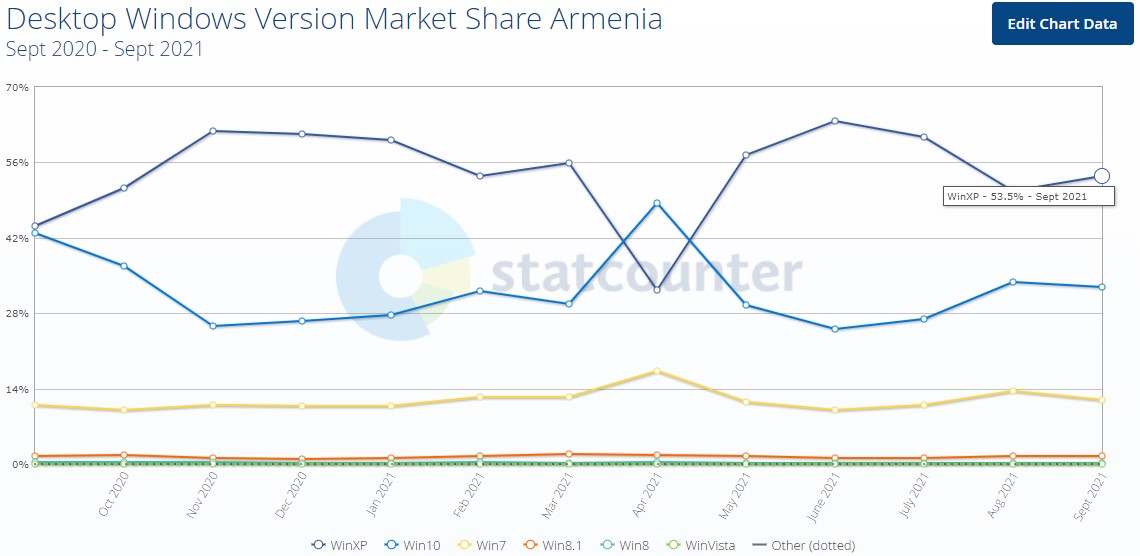KEEP IN TOUCH
Subscribe to our mailing list to get free tips on Data Protection and Cybersecurity updates weekly!







Today is the 20th anniversary of Windows XP, and although the operating system reached the end of support in 2014, way too many people continue to use the insecure version of Windows.
Windows XP was released on October 25, 2001, and is considered one of the most loved versions of Windows due to its ease of use, fast performance, and stability.
Today, after Microsoft has released Windows 7, 8, 10, and 11, a small but respectable number of people are still using the old operating system.
This continued usage is a testament to its success but also raises concerns regarding ts lack of security.
Also Read: The Importance of Penetration Testing for Businesses
Mainstream support for Windows XP ended on April 14, 2009, with extended support lasting another five years.
This means that anyone still running Windows XP has not received support from Microsoft for roughly 7.5 years now, including almost all security updates and fixes for vulnerabilities that may have been discovered.
That’s a massive amount of time in tech and more than enough to render the operating system a security nightmare with likely a large number of unpatched vulnerabilities.
While Microsoft has backported fixes for some of the more serious vulnerabilities in Windows XP, such as EternalBlue and BlueKeep, there are many more vulnerabilities that threat actors could exploit.
This makes connecting a Windows XP device to the Internet a risky proposition and why all security professionals recommend users upgrade to a supported version of Windows.
Also Read: Free Privacy Policy Compliance Review
While Vista felt like an experimental release for a beta version, Windows 7 was an excellent and refined release, and so was Windows 10. So, why are some systems still using the outdated XP version?
The first category of systems that are still using Windows XP is those belonging to public sectors, known for their crawling upgrade speeds and hesitancy to use new technologies.
For many public entities, the bureaucracy of approving new system license purchases, upgrading hardware, and training the entire public sector is too complicated and costly.
The compatibility of custom-made 32-bit software tools is another crucial reason for still seeing XP in many places like industrial environments, hospitals, etc.
In many cases, there are no newer versions of these critical tools, or companies need to pay a lot of money to have them ported to new systems.
Then there’s the category of people who are using hardware that is too old and weak to run a newer Windows version properly, and they see no good reason to replace something that is still (technically) working.
Shifting to Linux just for better support and security isn’t an option for most of these people, because simply put, Windows XP is what they have been used to using for so many years now.
And in some cases, best highlighted by Russian President Vladimir Putin two years ago, some consider Windows XP more trustworthy and safe against cyber-espionage than a newer version that sends large quantities of data back to Microsoft.

Windows 7 was when Microsoft added the “Telemetry” data collection system, and with Windows Vista being unreliable, those worried about this aspect of the OS’s functionality are stuck with XP.
According to StatCounter, the percentage of Windows users using the XP version of the OS in September 2021 is 0.59%, a significant number when you consider how many Windows systems are deployed worldwide.

The NetMarketShare platform gives the Windows XP operating system a noteworthy 0.26% market share for September 2021.
We also checked BleepingComputer’s analytics, and for the running month alone, we’ve had 19,000 unique visitors connecting to the site with Windows XP systems.
One very notable case is that of Armenia, where Windows XP is the most popular OS, enjoying a share of 53.5% among Windows users.

While the market share for Windows XP is relatively low, too many organizations and users still run this legacy version of Windows.
With cyberattacks and ransomware a constantly evolving threat, using outdated and unsupported systems is too great a risk for organizations, especially if these devices power critical systems.